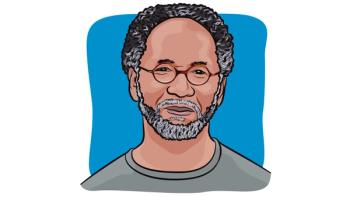A phase 3 international clinical trial evaluating the efficacy of uproleselan (GMI-1271) in combination with chemotherapy versus chemotherapy alone in patients with relapsed/refractory acute myeloid leukemia (AML) did not demonstrate a statistically significant improvement in overall survival (OS) in the intent-to-treat (ITT) population.
These findings presented at the 2024 ASH Annual Meeting.
At a median follow-up of 37.9 months, the median OS for the ITT population was 13 months among those in the uproleselan arm (194 patients) versus 12.3 months in the placebo plus chemotherapy arm (194 patients). This difference was not statistically significant. However, OS survival probabilities at 48 months were 34.1% for the uproleselan group and 25.5% for the placebo group.
Despite not meeting the primary OS end point, uproleselan showed encouraging results in certain subgroups, particularly for patients with primary refractory AML, who experienced a survival advantage.
“Unfortunately, this large international phase 3 study did not meet its overall primary end point of overall survival. However, I think there are some clinically meaningful benefits observed in the uproleselan arm across multiple predefined subgroups,” explained Dr. Daniel J. DeAngelo, chief of the Division of Leukemia at Dana-Farber Cancer Institute, during a presentation of the data.
Glossary:
Overall survival: the time from diagnosis or the start of treatment when a patient with cancer is still alive.
Intent-to-treat population: all patients who are randomly assigned to a treatment group regardless of whether they received the assigned treatment or completed the trial.
Oral mucositis: a side effect that causes painful sores and inflammation in the mouth and throat.
Complete response: the disappearance of all signs of cancer from treatment.
Complete response with incomplete count recovery: all signs of cancer have disappeared from the body, but the patient’s blood cell counts have not fully recovered.
Median duration of response: the midpoint of the time period during which patients experience a positive response to treatment.
Minimal residual disease: a very small number of cancer cells in the body after treatment.
CYP inhibition: when a medication interferes with the activity of an enzyme called CYP, which are crucial for metabolizing various substances in the body including drugs.
QTc prolongation: an indication on an electrocardiogram that can increase the risk for dangerous heart rhythms.
Differentiation syndrome: a side effect caused by a rapid release of cytokines from leukemia cells affected by anticancer drugs.
Patients with primary refractory AML, which consisted of 33% of enrolled patients, had a substantial benefit from uproleselan. The median OS in this patient population was 31.2 months with uproleselan (62 patients) versus 10.1 months with the placebo arm (66 patients).
The survival benefit was consistent regardless of the chemotherapy backbone used. For patients treated with fludarabine, cytarabine, idarubicin (FAI) chemotherapy combined with uproleselan, the hazard ratio was 0.53, indicating a survival advantage. For those treated with mitoxantrone, etoposide, cytarabine (MEC) chemotherapy plus uproleselan, the hazard ratio was 0.68, suggesting a trend toward benefit.
Study Design and Patient Characteristics
Uproleselan is an E-selectin antagonist that works by disrupting AML cell survival pathways and overcoming chemotherapy resistance. The agent can potentially deepen chemotherapy response.
This trial enrolled 388 patients aged 18 to 75 years, with either primary refractory AML or first or second relapse. Patients were required to be eligible for intensive salvage treatment.
Once enrolled, patients were randomly assigned to receive uproleselan with chemotherapy or chemotherapy alone, with MEC or FAI as the chemotherapy backbone, based on investigator choice. Uproleselan was administered during the induction phase and continued through up to three cycles of consolidation, with the option of proceeding to transplant.
The primary end point was OS. Key secondary end points were severe oral mucositis during induction, complete response (CR) and remission rates.
Additional Findings
The median duration of response (DOR) among the uproleselan-treated primary refractory patients was not reached, compared with a median DOR of 12.7 months in the placebo group.
Minimal residual disease (MRD) status at the end of induction was a key secondary end point of the study. In patients who achieved CR or CR or CR with incomplete count recovery (CRi), uproleselan showed a higher rate of MRD negativity. Among patients achieving CR, 67.1% of those treated with uproleselan were MRD-negative versus 61.5% in the placebo group.
Further, over 50% of patients in both arms underwent allogeneic stem cell transplantation (allo-SCT) after treatment. Notably, patients who underwent transplantation experienced a marked survival benefit when treated with uproleselan. Of those who achieved CR and proceeded to allo-SCT, the median OS was not reached (NR) for the uproleselan group compared with 24.8 months for the placebo group. The five-year survival probabilities for transplanted patients were 57.5% in the uproleselan arm versus 27.7% in the placebo arm.
Looking at safety, there was no increase in serious side effects or any grade 3 (severe) or higher treatment-emergent side effects observed with uproleselan. No discontinuations due to side effects were seen.
“There was no known CYP inhibition, QTc prolongation or differentiation syndrome seen in this study. The safety profile was consistent with what we expect from the chemotherapy backbone, with no significant differences,” explained DeAngelo, sharing that uproleselan did not add any extra toxicity to the chemotherapy backbone.
“While the study did not meet the primary endpoint of overall survival, the findings show clinically meaningful benefits in primary refractory AML and post-transplant survival, suggesting that uproleselan has the potential to improve outcomes in this challenging population,” added DeAngelo.
For more news on cancer updates, research and education, don’t forget to subscribe to CURE®’s newsletters here.






